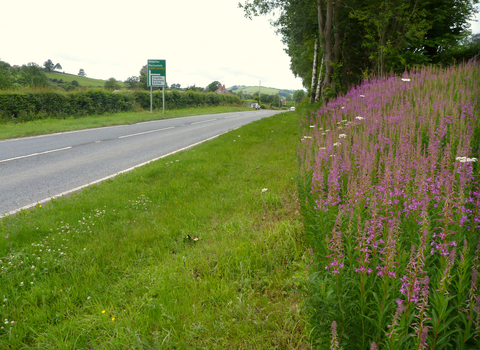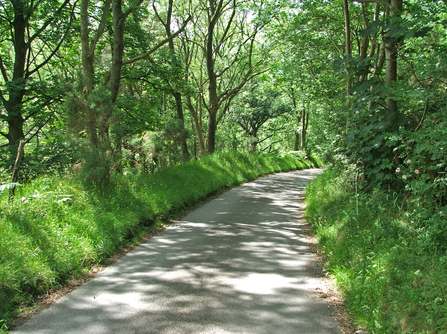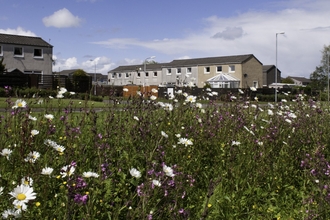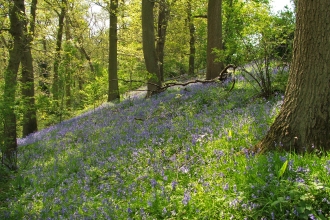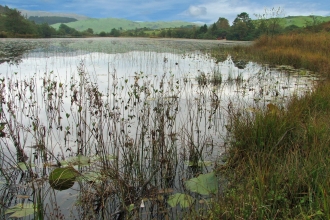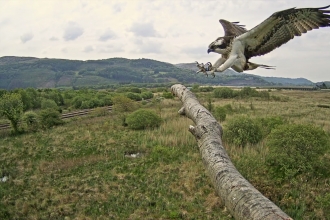Why they are important for people and wildlife
Very easily under-valued, but always around us, road verges are much more than simply the borders of our transport network.
Along the rural road network in particular, road verges are often the last vestiges of the habitats which once surrounded them. This particularly applies to meadows, 97% of which have been lost across the UK. In some cases, increasingly rare and threatened species, such as Wood Bitter-vetch, find refuge in road verges, whilst the habitats themselves contribute to a much bigger network, helping to connect up the landscape. This means that they are not only highways for us, but wildlife too.
Flowery verges can also be extremely pretty, giving us immense pleasure as we travel along next to them. For those of us who live in the more remote parts of Montgomeryshire, we may also regularly take exercise along the miles of unclassified roads in the area. There is no doubt that road verges make a meaningful contribution to our health and wellbeing.
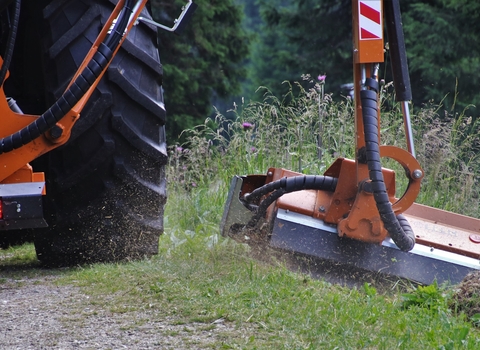
Road verge being cut by tractor & flail; image by pasja1000 on Pixabay
Threats & challenges
The biggest threat to road verges is modern management practices; many are cut too often and, in most cases the cuttings are left. These ‘arisings’ are detrimental to the quality of the grassland as they have a mulching effect – killing off many plants and depositing nutrients, encouraging just a few ‘thuggish’ species to dominate. By cutting flowers before they set seed and leaving arisings, the road verges gradually become less diverse. This is bad news for wildlife, but also creates an ever increasing management burden.
Whilst much less common, lack of management can also be a problem, especially where rare plants are lost under scrub encroachment. Localised damage can be caused by works, such as road-widening schemes or the installation of French drains, the scattering of wood chip or ditch clearance material, contamination by road salt and pesticides and by vehicles driving or parking on them.
Solutions
Road verges can make a significant contribution to addressing the climate & ecological emergency, as well as benefitting our health and well-being, if we look after them. In an ideal world, the default management of road verges would be an annual cut, after the wildflowers have set seed and those cuttings could be removed. In reality it is far from that simple!
Road safety is an important consideration and not just in terms of visibility, but also when the management is undertaken. Roads are becoming increasingly busy and this presents a significant challenge, not only in terms of safety, but also the impacts of management practices on road users. However, these challenges are not unsurmountable and there are an increasing number of successes, where the financial burden is reduced for the land manager, at the same time as the land being improved for wildlife.
You might think that road verge management is all about getting the Local Authority to do the right thing, but don’t forget that they work for us, so we all have a role to play in this. As well as over-coming the practicalities, we need a shift in our collective mindset; we need to re-learn to be less tidy! For some, an uncut verge seems unsightly, but this is a relatively recent construct, likely bleeding out from our obsession with neat, short, green lawns and manicured gardens. Nature is not like this, it is wonderfully complex and diverse and we should revel in this complexity.
If you’re a sufferer of ‘Obsessive Tidiness Disorder’, challenge yourself to think again; take a much closer look and really see the wonder of nature. Think about the life we share our planet with; do we really have more of a right than any other? Think about your favourite wild animals, what they need to survive and how road verges could help them. Think about what healthy road verges could do for us; for example, sucking up pollution from our vehicles. We all need a healthy ecosystem to survive. Road verges are not the solution to all our ills, but there are certainly part of it.
What is MWT doing?
Montgomeryshire Wildlife Trust has long recognised the value of road verges and this led to the ‘Living Highways Project’, a partnership between the three Powys wildlife trusts, Powys County Council (PCC), Powys Verges and Hedgerows Concern Group, Countryside Council for Wales and other groups, which ran between 2001 and 2006.
Living Highways project cut & collect machinery © MWT
Feasibility study
In 2005, the Living Highways project carried out a practical trial to investigate the feasibility of wide-scale collection of cuttings from roadside verges in Powys, for use in biogas and compost production.
One of the outcomes of the Living Highways project was the introduction of the Powys Road Verge Nature Reserves scheme. A Road Verge Nature Reserve (RVNR) is a length of road verge that has been identified as having particular value to wildlife and is subsequently managed by PCC with the aim of conserving and enhancing those features of interest. There are currently about 34 RVNRs in Montgomeryshire.
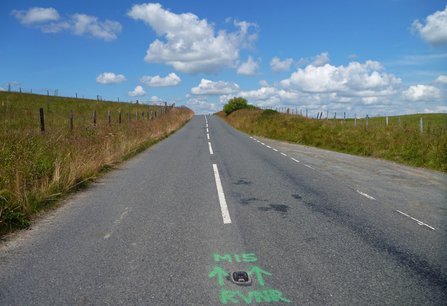
Road Verge Nature Reserve (RVNR) on a mountain road in Powys © MWT
2007 to 2020
Although the Living Highways project finished in 2006, PCC continued to work with the Powys wildlife trusts to survey and review RVNRs until 2014, when severe financial cuts pinched. Although RVNR management continues, without regular monitoring, we don’t know if that management is effective and if the features of the sites still exist.
As part of our ‘Where the Wild Things Are’ project (2016 to 2020), we carried out a review of the Powys Local Wildlife Site (LWS) selection criteria and this included the introduction of a new criterion for the selection of road verges as LWS. This is based on the RVNR system, but does not replace it. There is likely to be significant overlap between the two ‘designations’, but this is not considered a problem, as their purposes are different. LWS selection provides the opportunity to provide a greater level of protection for Powys’ most important road verges.
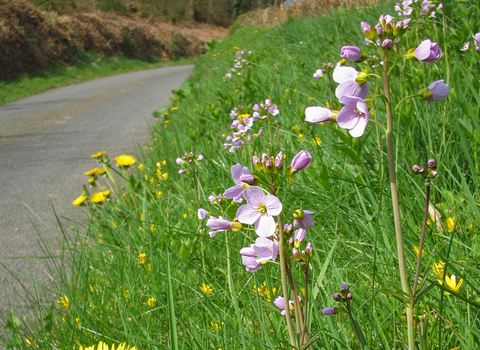
Flower-rich road verge in spring © Clive Faulkner
What is the future for Montgomeryshire’s road verges?
There is an increasing appreciation for the value of road verges and a growing number of successful examples of road verge management which benefits wildlife and people. It is time for the wildlife trusts to once again work with PCC to really transform our road verges into ‘Living Highways’. Fresh discussions have already begun – watch this space!
What can I do?
- Tackle the tidy – seek every opportunity to treat your own ‘Obsessive Tidiness Disorder’ and help others overcome theirs.
- Lobby your Local Authority – tell PCC that you want flower-rich road verges, not forgetting to congratulate them for a job well done, as well as reporting bad practice.
- Report your sightings – make a list of the plants growing in your local road verge and send it to us, making sure you clearly identify the location and length surveyed. RVNRs or LWS are usually selected on the basis of the plants growing there, as animals are more mobile, but records of other wildlife are welcomed too.
- Support our work – by joining MWT or making a donation you can directly contribute to our work for Powys’ road verges. If you can’t help us financially, but have some spare time, volunteer with us; people with botanical ID skills or experience of practical habitat management will be particularly useful.
- Litter pick – due to their location, road verges often suffer under the scourge of discarded litter. Not only can this be dangerous to animals, it can damage machinery and prevent the cuttings being used for compost.
- Be a good citizen – littering is not restricted to litter (which obviously you shouldn't drop!)! It might seem harmless to dispose of garden waste on ‘green’ land, but doing so affects the ecology of the site and can cause the spread of invasive non-native species. So, compost your garden waste at home or take it to a registered waste disposal site. Also avoid planting garden plants on road verges, for the same reasons.
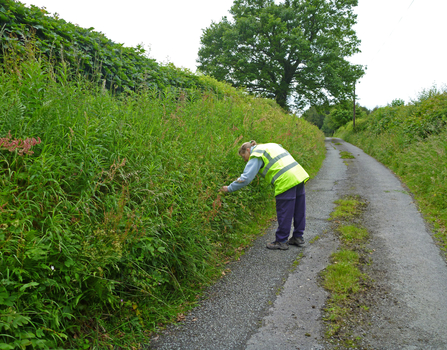
Road verge being surveyed by a volunteer © MWT

